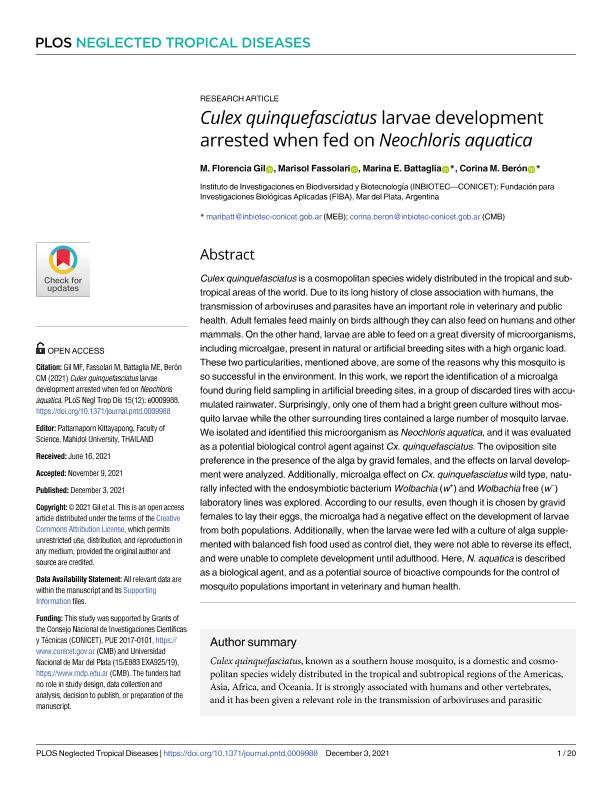Artículo
Culex quinquefasciatus larvae development arrested when fed on Neochloris aquatica
Fecha de publicación:
12/2021
Editorial:
Public Library of Science
Revista:
Neglected Tropical Diseases
ISSN:
1935-2735
Idioma:
Inglés
Tipo de recurso:
Artículo publicado
Clasificación temática:
Resumen
Culex quinquefasciatus is a cosmopolitan species widely distributed in the tropical and subtropical areas of the world. Due to its long history of close association with humans, the transmission of arboviruses and parasites have an important role in veterinary and public health. Adult females feed mainly on birds although they can also feed on humans and other mammals. On the other hand, larvae are able to feed on a great diversity of microorganisms, including microalgae, present in natural or artificial breeding sites with a high organic load. These two particularities, mentioned above, are some of the reasons why this mosquito is so successful in the environment. In this work, we report the identification of a microalga found during field sampling in artificial breeding sites, in a group of discarded tires with accumulated rainwater. Surprisingly, only one of them had a bright green culture without mosquito larvae while the other surrounding tires contained a large number of mosquito larvae. We isolated and identified this microorganism as Neochloris aquatica, and it was evaluated as a potential biological control agent against Cx. quinquefasciatus. The oviposition site preference in the presence of the alga by gravid females, and the effects on larval development were analyzed. Additionally, microalga effect on Cx. quinquefasciatus wild type, naturally infected with the endosymbiotic bacterium Wolbachia (w+) and Wolbachia free (w−) laboratory lines was explored. According to our results, even though it is chosen by gravid females to lay their eggs, the microalga had a negative effect on the development of larvae from both populations. Additionally, when the larvae were fed with a culture of alga supplemented with balanced fish food used as control diet, they were not able to reverse its effect, and were unable to complete development until adulthood. Here, N. aquatica is described as a biological agent, and as a potential source of bioactive compounds for the control of mosquito populations important in veterinary and human health.
Palabras clave:
Culex
,
Neochloris
,
biocontrol
Archivos asociados
Licencia
Identificadores
Colecciones
Articulos(INBIOTEC)
Articulos de INSTITUTO DE INV. EN BIODIVERSIDAD Y BIOTECNOLOGIA
Articulos de INSTITUTO DE INV. EN BIODIVERSIDAD Y BIOTECNOLOGIA
Citación
Gil, María Florencia; Fassolari, Marisol; Battaglia, Marina Esther; Berón, Corina Marta; Culex quinquefasciatus larvae development arrested when fed on Neochloris aquatica; Public Library of Science; Neglected Tropical Diseases; 15; 12; 12-2021; 1-20
Compartir
Altmétricas




